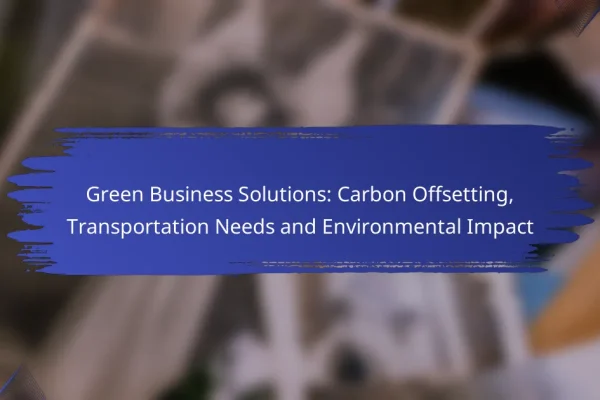What are the sustainable transportation solutions in the United States?
Sustainable transportation solutions in the United States include various methods aimed at reducing environmental impact while enhancing mobility. These solutions focus on electric vehicles, public transit systems, bicycle-sharing programs, carpooling initiatives, and alternative fuels.
Electric vehicles
Electric vehicles (EVs) are powered by electricity rather than gasoline or diesel, significantly reducing greenhouse gas emissions. They can be charged at home or at public charging stations, which are increasingly available across urban and suburban areas.
When considering EVs, look for models with a range that suits your daily driving needs, typically between 150 to 300 miles on a full charge. Incentives like tax credits and rebates may also be available to lower the initial purchase cost.
Public transit systems
Public transit systems, including buses, subways, and light rail, provide an efficient alternative to individual car use. They help reduce traffic congestion and lower emissions by transporting many passengers at once.
To maximize the benefits of public transit, familiarize yourself with local routes and schedules. Many cities offer mobile apps for real-time tracking and fare payment, making it easier to incorporate public transit into your daily routine.
Bicycle-sharing programs
Bicycle-sharing programs allow individuals to rent bicycles for short periods, promoting cycling as a sustainable transportation option. These programs are often found in urban areas, making it convenient for short trips and reducing reliance on cars.
When using a bike-sharing program, check for docking stations near your starting and ending points. Many programs offer affordable daily or monthly passes, making it a cost-effective choice for commuters and tourists alike.
Carpooling initiatives
Carpooling initiatives encourage individuals to share rides, reducing the number of vehicles on the road and lowering emissions. Many organizations and apps facilitate carpooling by connecting drivers with passengers heading in the same direction.
To participate in carpooling, consider joining local groups or using apps designed for ride-sharing. Establish clear agreements on costs and schedules to ensure a smooth experience for all participants.
Alternative fuels
Alternative fuels, such as biodiesel, ethanol, and hydrogen, offer eco-friendly options for powering vehicles. These fuels can reduce dependence on fossil fuels and lower emissions when used in compatible vehicles.
When exploring alternative fuels, research local availability and infrastructure, as some fuels may require specific vehicle modifications or fueling stations. Government incentives may also be available to support the transition to alternative fuel vehicles.
How can businesses implement green transportation solutions?
Businesses can implement green transportation solutions by adopting practices that reduce their carbon footprint and enhance sustainability. Key strategies include conducting transportation audits, investing in electric vehicle fleets, and partnering with local transit authorities.
Conduct a transportation audit
A transportation audit involves evaluating current transportation practices to identify inefficiencies and areas for improvement. This process helps businesses understand their carbon emissions, fuel consumption, and overall logistics performance.
To conduct an effective audit, gather data on vehicle usage, routes, and fuel types. Analyze this information to pinpoint high-emission activities and explore alternatives that could reduce environmental impact.
Invest in electric vehicle fleets
Transitioning to electric vehicle (EV) fleets can significantly lower greenhouse gas emissions and fuel costs. Businesses should assess their operational needs and determine the right mix of electric and conventional vehicles.
Consider factors such as range, charging infrastructure, and total cost of ownership when selecting EVs. Many companies find that government incentives and lower maintenance costs make EVs a financially viable option over time.
Partner with local transit authorities
Collaborating with local transit authorities can enhance a business’s green transportation efforts by promoting public transit use among employees. This partnership can lead to initiatives such as subsidized transit passes or shuttle services that connect to public transport.
Engaging with local authorities also allows businesses to stay informed about new transit developments and sustainability programs, which can further support their green transportation goals.
What are the benefits of sustainable transportation for businesses?
Sustainable transportation offers businesses numerous advantages, including reduced operational costs, improved public perception, and adherence to environmental regulations. By adopting eco-friendly transport solutions, companies can enhance their bottom line while contributing positively to the environment.
Cost savings on fuel
Implementing sustainable transportation methods can lead to significant fuel savings for businesses. Companies that invest in fuel-efficient vehicles or alternative energy sources, such as electric or hybrid models, often see reductions in fuel expenses ranging from 20% to 50% over time.
Additionally, optimizing delivery routes and using telematics can further decrease fuel consumption. Businesses should regularly review their transportation strategies to identify opportunities for cost savings.
Enhanced brand reputation
Adopting sustainable transportation practices can significantly enhance a company’s brand reputation. Consumers are increasingly favoring businesses that demonstrate a commitment to environmental responsibility, which can lead to increased customer loyalty and market share.
Promoting eco-friendly initiatives through marketing and public relations can attract environmentally conscious consumers. Companies can showcase their sustainable practices by participating in green certifications or partnerships with environmental organizations.
Compliance with regulations
Many countries have established regulations aimed at reducing carbon emissions and promoting sustainable transportation. By adopting eco-friendly practices, businesses can ensure compliance with these laws, avoiding potential fines and penalties.
Staying informed about local regulations, such as emissions standards or incentives for electric vehicles, is crucial. Companies should regularly assess their transportation policies to align with evolving legal requirements and take advantage of available incentives.
What criteria should businesses consider when choosing sustainable transportation options?
Businesses should evaluate cost-effectiveness, environmental impact, and employee accessibility when selecting sustainable transportation options. These criteria help ensure that the chosen solutions are practical, beneficial for the environment, and supportive of employee needs.
Cost-effectiveness
Cost-effectiveness is crucial for businesses aiming to implement sustainable transportation. Companies should analyze both upfront costs and long-term savings, such as reduced fuel expenses and maintenance costs associated with electric or hybrid vehicles.
Consider using a total cost of ownership (TCO) model to compare different transportation options. This model accounts for purchase price, fuel costs, maintenance, and potential tax incentives for eco-friendly vehicles, which can significantly affect overall expenses.
Environmental impact
Assessing the environmental impact of transportation choices is essential for sustainability. Businesses should look for options that reduce greenhouse gas emissions, such as electric vehicles, public transportation, or carpooling initiatives.
Utilizing tools like carbon footprint calculators can help quantify the environmental benefits of various transportation methods. This data can guide decisions toward options that align with corporate sustainability goals and regulatory standards.
Employee accessibility
Employee accessibility is a key factor in choosing sustainable transportation. Options should be convenient and practical for employees to encourage their use, such as proximity to public transport or availability of bike lanes.
Offering incentives like subsidies for public transportation or providing company bikes can enhance accessibility. Regular surveys can help understand employee preferences and barriers, allowing businesses to tailor their transportation solutions effectively.
What are the challenges of adopting sustainable transportation?
Adopting sustainable transportation presents several challenges, including financial, infrastructural, and cultural barriers. Organizations must navigate initial costs, limited infrastructure, and the need for employee support to successfully implement eco-friendly transport solutions.
Initial investment costs
The initial investment costs for sustainable transportation can be significant, often deterring businesses from making the switch. Companies may need to invest in electric vehicles, charging stations, or alternative fuel sources, which can range from thousands to millions of dollars depending on the scale.
To mitigate these costs, businesses can explore government incentives or grants that support green initiatives. Additionally, calculating long-term savings from reduced fuel and maintenance expenses can help justify the upfront investment.
Infrastructure limitations
Infrastructure limitations pose a major hurdle for sustainable transportation. Many regions lack the necessary charging stations or public transport options to support electric vehicles and other green alternatives. This can lead to range anxiety for electric vehicle users and limit the practicality of adopting such solutions.
To address these limitations, businesses can collaborate with local governments to advocate for improved infrastructure. Investing in on-site charging stations or partnering with existing public transport systems can also enhance accessibility for employees.
Employee buy-in
Gaining employee buy-in is crucial for the successful adoption of sustainable transportation. Employees may be resistant to change due to concerns about convenience, costs, or unfamiliarity with new systems. Engaging them early in the process can help alleviate these concerns.
Offering incentives such as subsidies for public transport or carpooling programs can encourage participation. Providing education on the benefits of sustainable transportation can also foster a culture of environmental responsibility within the organization.
How do local policies affect sustainable transportation initiatives?
Local policies play a critical role in shaping sustainable transportation initiatives by providing frameworks that encourage or discourage eco-friendly practices. Regulations, incentives, and infrastructure investments can significantly influence the adoption of sustainable transport options like public transit, cycling, and electric vehicles.
Incentives for electric vehicles
Incentives for electric vehicles (EVs) are designed to promote their adoption and reduce reliance on fossil fuels. These incentives can include tax credits, rebates, reduced registration fees, and access to carpool lanes, which collectively lower the overall cost of ownership for consumers.
For example, in the United States, federal tax credits can range from $2,500 to $7,500 depending on the battery capacity of the vehicle. Many states offer additional incentives, which can further decrease the purchase price. Local governments may also provide benefits such as free charging stations or exemptions from tolls.
When considering EV incentives, it’s essential to research the specific programs available in your area, as they can vary widely. Additionally, staying informed about changes in policy can help maximize the benefits available to you as an EV owner.











